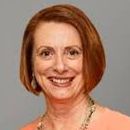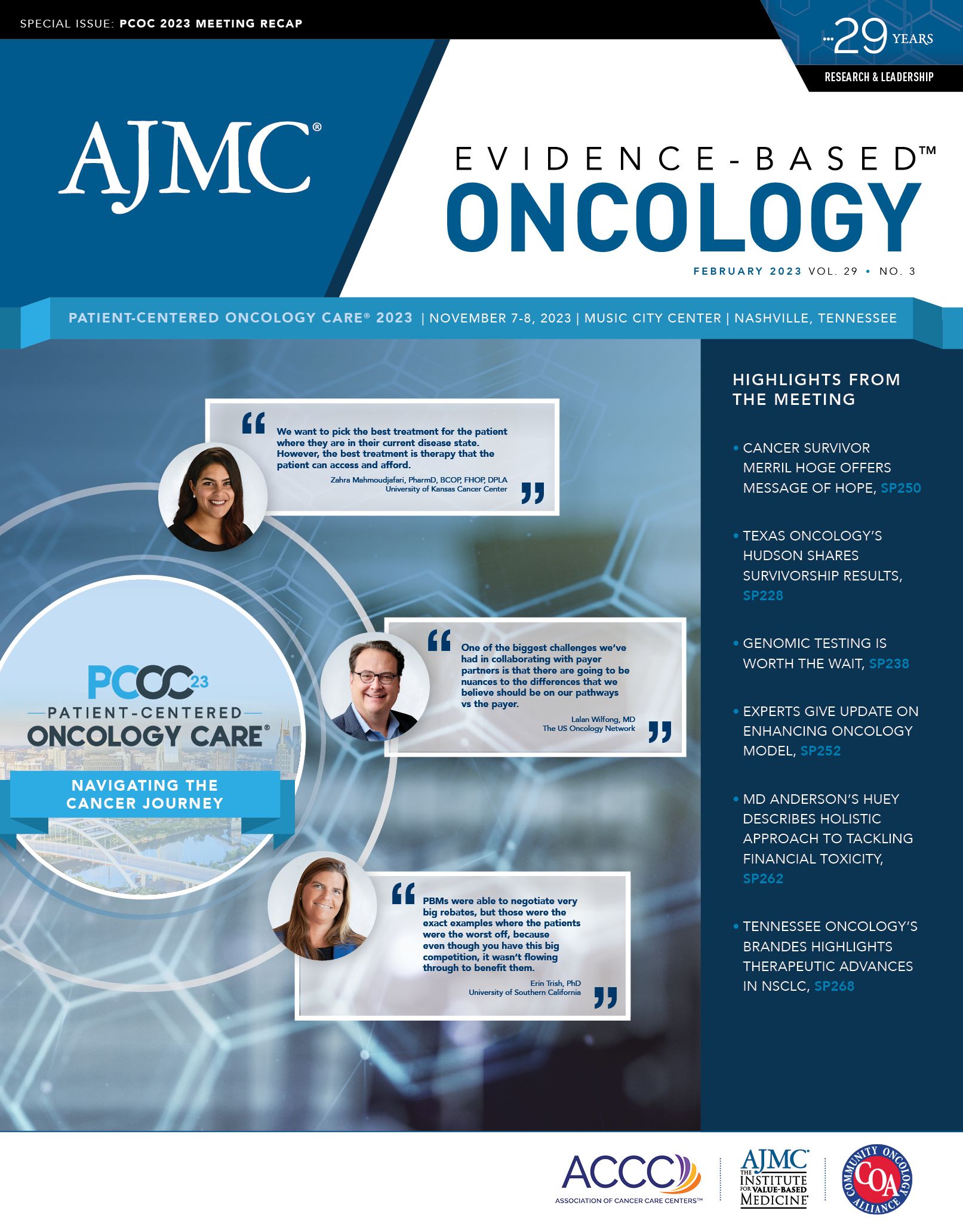- Center on Health Equity & Access
- Clinical
- Health Care Cost
- Health Care Delivery
- Insurance
- Policy
- Technology
- Value-Based Care
Innovation in Value-Based Care Requires More Data, Patient-Centered Thinking
Experts discussed the Enhancing Oncology Model and themes in the movement toward value-based care in oncology during Patient-Centered Oncology Care 2023.
With the Enhancing Oncology Model (EOM) now underway for the 44 oncology practices that enrolled in the model by July 1, 2023,1 continued innovation in the value-based care space seems inevitable. But change does not come without challenges, and providers have voiced many as they strive to provide quality care to patients while meeting cost and quality metrics set by value-based models in oncology.
Wilfong

In a panel discussion at the 2023 Patient-Centered Oncology Care meeting held in Nashville, Tennessee, moderator Lalan Wilfong, MD, senior vice president of payer and care transformation at The US Oncology Network, led experts through a discussion of the EOM and key tools in for providers in the movement toward value-based care in oncology.
The EOM is a Medicare alternative payment model (APM) that began in July 2023, and the successor to the Oncology Care Model (OCM), which ended in June 2022.2,3 In his introduction to the discussion, Wilfong credited the OCM with changing the dialogue around cancer care delivery in the United States. The EOM, however, has been met with much concern from oncology practices—even those that advocated for value-based care during the OCM.4
The panel also featured the following members:
- Glenn Balasky, executive director at Rocky Mountain Cancer Centers
- Stephen “Fred” Divers, MD, chief medical officer of the American Oncology Network and medical oncologist with Genesis Cancer and Blood Institute
- Tracy Spinks, director of value-based care at Optum Health
- Amy Valley, PharmD, vice president of clinical strategy and technology solutions at Cardinal Health
Despite the concerns around the EOM, there was agreement among panelists that value-based care is the way forward in cancer care.
Valley

At the start of the discussion, Valley noted that technology can play a big part in success under value-based reimbursement agreements by providing insight into practice performance, which is crucial knowledge given the various quality and cost metrics assessed in models like the OCM or EOM.
In the commercial payer space, there has also been a big push for value-based reimbursement, and Divers provided his perspective on the motivations behind the shift toward value-based agreements.
Divers

“They want to make sure we’re good stewards of their health care dollars,” Divers said, noting that technology can certainly play a role in determining how to make those dollars go far without adversely affecting patients. “I think we have to continue to partner with [payers] to try to help find a way to make those dollars go further and to get the right therapy to the right patient, and be comfortable making decisions which sometimes are difficult—to perhaps better navigate the waters of, ‘Hey this is a high-cost therapy that may not really provide any meaningful benefit or could potentially cause harm.’”
The key, he said, is getting to a place where that dialogue can be shared.
The discussion circled back to the analysis aspect of success in value-based care. A major concern during the OCM was a lack of real-time data for providers to gauge performance in real time. In the current landscape, tools that can help not only track but also predict performance could prove key in adjusting strategies throughout the execution of value-based APMs.
“I think it’s really exciting to see the degree of innovation that’s ongoing and the tools that are really coming into practice,” Valley said. “So it’s not just this vision of having artificial intelligence and predictive analytics coming into bedside and coming into our care decisions. It’s really happening and it’s happening in a meaningful way.”
Tools to help manage population health, not just cancer care, will also be important to facilitate value-based care overall in the long run, Valley said.
But the realm of technology has its challenges, one of which is the delay from the conceptualization of a tool to its creation.
Balasky

“I know we want more technology to feed stuff in, but there’s always going to be gaps. The dilemma of health care is even if something becomes a steady idea in health care today, it’ll probably take us 3 years before we’re even close to having a tech that lines up with it, because that’s just the way it works,” Balasky said.
Valley agreed that innovation in technology is slower than the pace of the lessons learned so far in value-based reimbursement, but that focusing analytics on the most common things that will benefit all patients from a care management standpoint, as well as tools to understanding the biggest drivers of cost, is a great starting point.
Another challenge has been testing models successfully in oncology, Spinks explained, noting that the pace of oncology innovation has been rapid and the economics of cancer treatment have changed substantially. Practices have succeeded in measures like bringing down hospitalization rates and emergency visits in novel care models, but costs for oncology care remain high.
Wilfong noted that in recent years, oncology has become a point of interest for employer groups. Whereas musculoskeletal conditions were previously the areas of highest health care spending, cancer has unfortunately taken the top spot in recent years, he said.
Spinks

“What we can’t seem to crack is that what’s driving the cost in oncology, particularly for medical oncology, is the cost of the drugs,” Spinks said. “And so that’s where we start to think about, well, should they be bifurcated? Should we be focusing on quality separately from cost?” There may be a different way to look at this issue without making things harder on providers or patients, she added.
Wilfong noted the difficulty of assessing the true cost of novel therapies, which may come at a substantial cost up front but often lead to longer disease-free intervals that should be factored into the equation.
Spinks reiterated the importance of gleaning information from data, not just delivering sheer numbers to providers. Wilfong added that those data could be used to answer questions that cannot be answered in trials. One example is drug dosage questions; in some cases, there may be opportunities to use less of a drug without compromising outcomes, Wilfong noted.
Overall, the panel concurred, the potential for continued progress leans on how data are collected and utilized both in real time and in the long term. In the end, both practices and the push for value-based care aim to improve care for patients in a cost-conscious way, so ongoing collaboration between stakeholders will be an important part of the equation.
References
1. Caffrey M. Final tally lists 44 practices in EOM, but it’s complicated. American Journal of Managed Care. July 12, 2023. Accessed November 9, 2023. https://bit.ly/3vo1Ov7
2. Enhancing Oncology Model. Centers for Medicare & Medicaid Services. Updated March 6, 2023. Accessed November 9, 2023. https://innovation.cms.gov/innovation-models/enhancing-oncology-model
3. Oncology Care Model. Centers for Medicare & Medicaid Services. Updated November 18, 2022. November 9, 2023. https://innovation.cms.gov/innovation-models/oncology-care
4. Caffrey M. Final EOM list favors larger practices; AON strategy helps smaller groups. Am J Manag Care. 2023;29(Spec No. 7):SP633-SP635. doi:10.37765/ajmc.2023.89421

Blister Packs May Help Solve Medication Adherence Challenges and Lower Health Care Costs
June 10th 2025Julia Lucaci, PharmD, MS, of Becton, Dickinson and Company, discusses the benefits of blister packaging for chronic medications, advocating for payer incentives to boost medication adherence and improve health outcomes.
Listen
